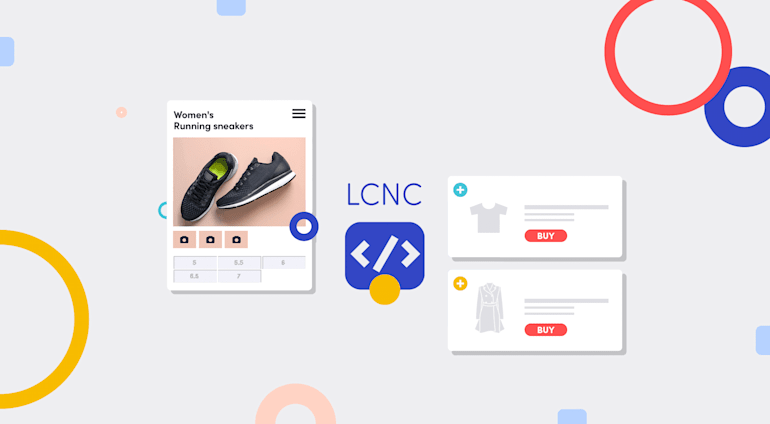Consumers expect modern websites to be mainly visual. But, the more compelling and complex the related media is, the more data is involved, compounding the site’s weight. In today’s content-craving world, delivering unoptimized media can cost you because it leads to sluggish page loads, resulting in visitors abandoning your site in search of a faster alternative. In fact, a page load that takes more than three seconds can cause as many as 40% of your visitors to bounce. Given this competitive, digital-first environment, you can’t afford to lose page views, for time is of the essence.
What’s more, e-commerce teams tasked with creating visual experiences need the support of developers. Alignment and a shared sense of purpose is paramount for generating high-quality output, and then automation can handle the rest.
To achieve all that, brands should turn to the emerging low-code and no-code (LCNC) technology.
LCNC Tools Boost Innovation in the Long Haul
Designated LCNC tools reduce the need for software code or eliminate it altogether. Traditionally, developers rely on easy-to-use visual mechanics, such as prebuilt connections that are intuitive to marketers or the drag-and-drop capability. Just because a company embraces LCNC tools doesn’t mean that it’ll be phasing out developer talent, not at all. Rather, instead of being bogged down by such mundane tasks as creating media variants, developers are then freed up to innovate, not only benefitting the company’s bottom line in the long run, but also earning a rewarding and inspiring experience for themselves.
Instead of being just a run-of-the-mill trend, LCNC tools are being adopted more and more by businesses for workflows. According to ZDNet, LCNC platforms “offer the promise of solving business problems and expediting digital transformation initiatives.” And no wonder: Since no proficiency with programming languages is required for their use, LCNC tools can speed up time to market and innovation.
Several industry insiders have lauded LCNC as the way of the near future:
- A TechRepublic Premium survey found that nearly half (47%) of its respondents currently use LCNC software. Furthermore, 20% say that they plan to do that within the next year.
- Forrester estimates that the low-code market will grow by 40% annually, amounting to a total spending of $21.2 billion by 2022.
- Gartner suggests that, by 2024, 65% of application development will be low-code. As for media optimization, LCNC greatly benefits marketers and developers by streamlining workflows, shortening engineering cycles, and saving time and manpower.
Media Optimization With LCNC Yields Many Benefits
LCNC bolsters the process of building online user experiences in two major areas:
- Collaboration. In e-commerce, the creative team devotes a lot of time brainstorming and running down innovative tangents to create appealing and persuasive visual media assets—images, videos, animations, and 3d models that deliver a great shopping experience. However, without the help of code-savvy colleagues to leverage these assets for online properties like web pages or apps, content creation cannot come to life. LCNC tools foster close collaboration among siloed or disparate groups. Furthermore, design professionals become much less dependent on developers, reducing the time and resource demands on the latter. As a result, instead of tinkering with image and video variants, developers can focus on forging code that really counts and on pursuing innovative projects.
- Workflows. With LCNC, businesses can efficiently and easily create visual experiences—a website, a pop-up, a product page, an app, a chatbot. Minimal or no code accelerates the creation, testing, and deployment processes.
Moreover, LCNC enables companies to iterate fast, especially through proof of concepts. With out-of-the-box, vendor-made solutions, companies can be off to the creation races quickly, but not customizations. Gratifyingly, LCNC tools offer tailoring capabilities that help you reach agile and precise development milestones.
Cloudinary’s Media Optimizer Helps Create the Best E-Commerce On Time
Today’s websites with their extensive visual elements should not come at a price just because images and videos take up a slew of bandwidth. Rather, those media assets should be a plus, engaging with and converting visitors. Gone are the days when brands were forced to choose one over the other, prioritizing quality to the detriment of performance, or vice versa.
Cloudinary’s Media Optimizer optimizes images and videos so that they work in your favor. Here are three major capabilities you can leverage:
- Automatic format selection. The Media Optimizer automatically adapts images and videos to the most optimized format based on the viewer’s device, operating system, and browser.
- Quality-led compression. With Cloudinary’s quality-led optimization techniques, the Media Optimizer finds the sweet spot between file size and quality based on the actual content and viewer device.
- Perfect rendering on all devices. The Media Optimizer ensures that rich media is displayed correctly on all device types, including desktops, tablets, and smartphones. Why not start planning for a performance hike of your web-based media? To learn more about LCNC technology or to see Cloudinary’s Media Optimizer in action, schedule a demo with us.





